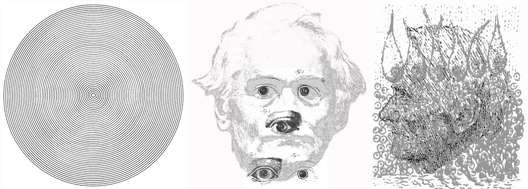Jan Evangelista Purkinje1787–1869
The 19th century witnessed the transformation of microscopy by the introduction of powerful achromatic instruments. In 1832 Purkinje obtained an achromatic microscope made by Plössl. He directed it at the large cells in the cerebellum, thereby identifying his eponymous cells. His microscopic observations were made before any adequate staining methods had been developed. Purkinje used alcohol to fix his preparations, and he made thin sections so that they could be examined microscopically. It is an irony of science that Purkinje was not able to resolve the amazingly detailed structure of the cells bearing his name. Nonetheless, he invaded our bodies: there are Purkinje cells in the brain, Purkinje fibres around the heart, Purkinje images are reflected from the optical surfaces of the eye, a Purkinje tree can be rendered visible, and at twilight we can experience the Purkinje shift. In the 1820s he wrote two influential books on subjective visual phenomena because he believed that “visual illusions reveal visual truths”. In his first book (1823) he gave detailed descriptions of phenomena such as afterimages, the visibility of the retinal blood vessels (the Purkinje tree), and the distortions that are produced when viewing regular geometrically periodic patterns, like concentric circles. In his second book (1825) he described the difference in the visibility of coloured objects when seen in daylight and twilight - blue objects appear lighter and red ones darker in twilight (the Purkinje shift). He also studied distinct and indistinct (central and peripheral) vision, noting the greater sensitivity to movement in the periphery, but its poorer spatial acuity and color perception. The motion aftereffect was described thus: “One time I observed a cavalry parade for more than an hour, and then when the parade had passed, the houses directly opposite appeared to me to move in the reversed direction to the parade.” This phenomenon was related to a variety of vertiginous effects that follow from body movements. Purkinje’s interests in vision were stimulated by reading Goethe’s Farbenlehre and he was encouraged in his researches by Goethe (to whom his second book is dedicated) because of his use of the phenomenological method. Purkinje was born in Bohemia and studied medicine at Prague, where he carried out many experiments with self-administered drugs, considering that such results were more revealing than experiments on animals. Most of his experimental research in both physiology and histology was conducted in Breslau, but at the age of sixty three he was called to the chair of physiology in Prague, where he became one of the most ardent advocates of Czech nationalism. Purkinje is recognised by physiologists, who admire his attempts to relate structure to function, by pharmacologists, who marvel at his heroic experiments on self-administered drugs, and by forensic scientists, who acknowledge his role in the use of fingerprints for identification. Purkinje’s portrait is shown three times. On the left, his face is partially hidden in a pattern of concentric circles, like one illustrated in his first book on Sehen in subjektiver Hinsicht; if the pattern is observed for some seconds the circles themselves will appear to distort, and spokes will seem to radiate from the centre and rotate. When the whole pattern is out of focus his face can be seen. Purkinje considered that the distortions were due to the overlap of the image with its afterimage, but it is now known to be caused by transient astigmatic changes in the crystalline lens. In the centre, a full face portrait is combined with the illustration of the 'Purkinje images' taken from his inaugural address at the University of Breslau. On the right, Purkinje is shown in profile together with his illustration of 'Purkinje cells' in the cerebellum which he published in 1837.
